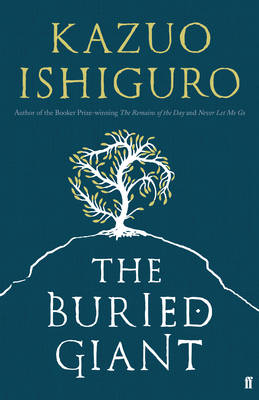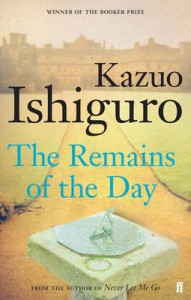 My first Ishiguro book, Nocturnes is a cycle of ‘five stories of music and nightfall’ (says the front cover). I spent most of the book feeling curiously unsatisfied; and I still feel that way now I’ve finished it. As far as I can see, the stories are linked so tenuously as to be hardly worth considering as a ‘cycle’. If Ishiguro has a wider point to make with them, I’m not sure what that point is. And if the tales are meant to be entertaining, insightful, or moving… well, bar a couple of moments, I didn’t really find them so.
My first Ishiguro book, Nocturnes is a cycle of ‘five stories of music and nightfall’ (says the front cover). I spent most of the book feeling curiously unsatisfied; and I still feel that way now I’ve finished it. As far as I can see, the stories are linked so tenuously as to be hardly worth considering as a ‘cycle’. If Ishiguro has a wider point to make with them, I’m not sure what that point is. And if the tales are meant to be entertaining, insightful, or moving… well, bar a couple of moments, I didn’t really find them so.
To take each story in turn: we begin with ‘Crooner’, in which a guitar player in Venice encounters Tony Gardner, a faded American singing star. Gardner enlists the musician to help him give one last serenade to his wife, Lindy, from whom Gardner is about to separate, despite the couple still being very much in love. I don’t follow the logic behind the separation, but this sets up one of the recurring features of the five stories: people (and especially couples) behaving in ways that don’t make much outward sense.
In ‘Come Rain or Come Shine’, the narrator, Raymond, is invited from his life as a teacher in Spain to stay with old university friends in London . The couple’s relationship is strained, but Charlie believes that if, whilst he’s away at a conference, his wife Emily spends time with Raymond (the musical connection here is that Raymond and Emily shared a love of old Broadway songs at university), she’ll stop thinking that Charlie hasn’t made much of his life, because she’ll see that Raymond has achieved so much less.
Eh? I know it takes all sorts to make a world, different people react to situations in different ways; but how many people would really stand for effectively being dismissed like that, as Raymond does? And what sort of person would come up with a scheme like that in the first place? The whole thing gets more and more farcical, as Raymond reads Emily’s diary and tries desperately to cover his tracks. The tale goes so far into absurdity that it comes out the other side and ends up strangely believable; it reminded me of Roald Dahl’s work, which is no bad thing. It’s the absurd humour that makes ‘Come Rain or Come Shine’ one of the more enjoyable stories in Nocturnes.
Next is ‘Malvern Hills’, in which a struggling guitarist leaves London for the summer to help out at his sister’s Herefordshire café. He meets a Swiss couple whose attitude seems to change with each encounter; and discovers that the relationship between his sister and her husband may be more fragile than he thought. This story highlights one of Ishiguro’s weaknesses: his five first-person narrators sound very similar, which he might just about get away with in the right circumstances; but the narrators in Nocturnes are too diverse – the voice that suits middle-aged Raymond doesn’t suit the (presumably) young guitarist, for example. Ishiguro has more success in creating the voices of characters whose first language is not English; though, admittedly, that slightly formal, awkward manner of speaking is not too much of a stretch from (what I assume to be) the author’s ‘default’ style.
In the story ‘Nocturne’, we meet Steve, a saxophonist who’s reluctantly undergoing plastic surgery at an exclusive clinic, the operation being funded by his ex-wife’s new lover (again, this does not make a lot of sense to me). We learn about his dealings with the patient next door, a recently divorced Lindy Gardner (the only character to appear in more than one of these stories). There’s one very amusing scene where Steve and Lindy are trying to return a trophy that she’s pinched to give to him; but the rest – like so much of Nocturnes – feels quite flat.
Finally, ‘Cellists’ relates (at one remove) how a jobbing European cellist met, and became mentored by, the self-proclaimed virtuoso American cellist Eloise McCormack, who never played a single note on a cello in all the time he knew her. Again, I don’t follow the reasoning behind her behaviour, such reasoning as there is.
What does Ishiguro say about music in these stories? To be honest, the presence of music seems almost incidental (pardon the pun). My best guess is that Ishiguro aims to say that a shared love of music can be the glue holding together a foundering relationship, or the only thing left after a relationship is over, and variations on that theme. In which case, fine – but one could say the same about food, or books, or gardening, or myriad other things. I gain very little sense from these tales of what is special about music specifically.
What does Ishiguro say about human beings in these stories? The problem here is that the most significant relationships in Nocturnes are being examined from the outside; the enigmatic characters whom we’d like to know more about stay enigmatic, because the narrators can see no further into their minds than we can. The blurb mentions a theme of ‘the struggle to keep alive a sense of life’s romance’; I can see this in some of the stories, but I doubt I’d have picked it out as a ‘theme’ were it not for that hint in the blurb.
It’s a strange situation when the best parts of a book are the exact opposite of its dominant mood, but such is the case with Nocturnes. I don’t know if Kazuo Ishiguro has ever written comedy, but I’d love to read the results if he did. As for this book, however… aside from the odd hilarious scene in two of the tales, my overriding impression of Nocturnes is of a collection of stories that, rather politely, don’t say or do very much.
Like this:
Like Loading...




 My first Ishiguro book, Nocturnes is a cycle of ‘five stories of music and nightfall’ (says the front cover). I spent most of the book feeling curiously unsatisfied; and I still feel that way now I’ve finished it. As far as I can see, the stories are linked so tenuously as to be hardly worth considering as a ‘cycle’. If Ishiguro has a wider point to make with them, I’m not sure what that point is. And if the tales are meant to be entertaining, insightful, or moving… well, bar a couple of moments, I didn’t really find them so.
My first Ishiguro book, Nocturnes is a cycle of ‘five stories of music and nightfall’ (says the front cover). I spent most of the book feeling curiously unsatisfied; and I still feel that way now I’ve finished it. As far as I can see, the stories are linked so tenuously as to be hardly worth considering as a ‘cycle’. If Ishiguro has a wider point to make with them, I’m not sure what that point is. And if the tales are meant to be entertaining, insightful, or moving… well, bar a couple of moments, I didn’t really find them so.
Recent Comments